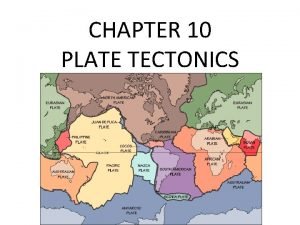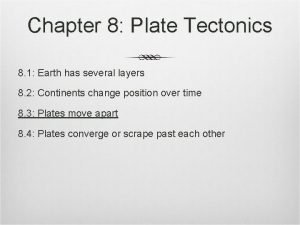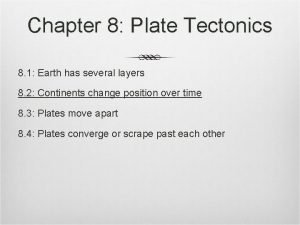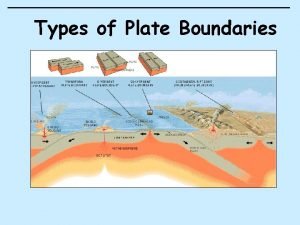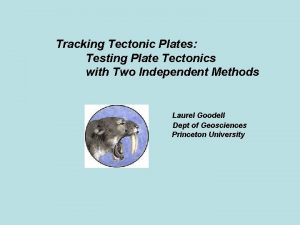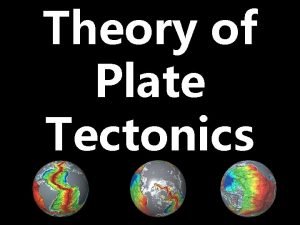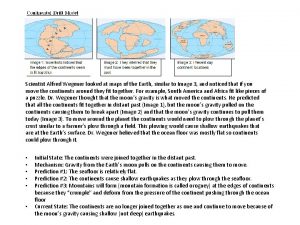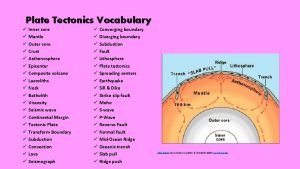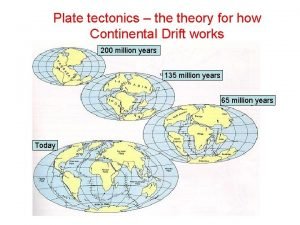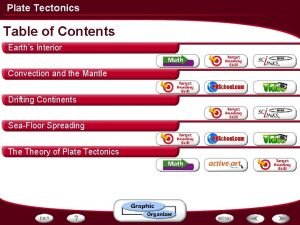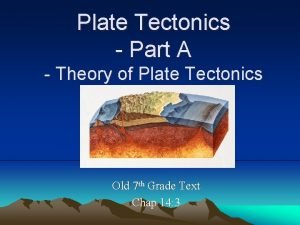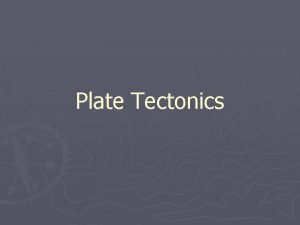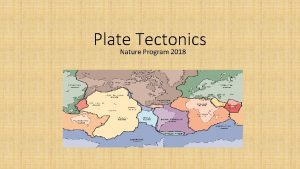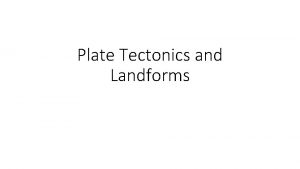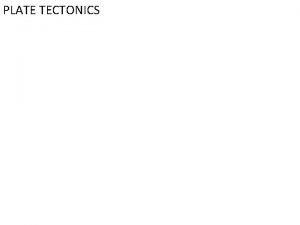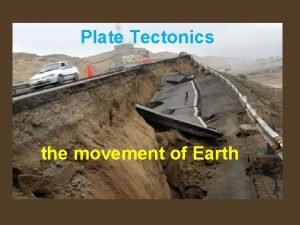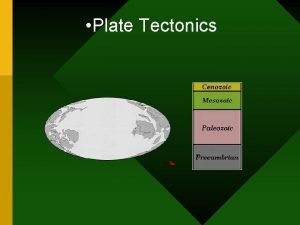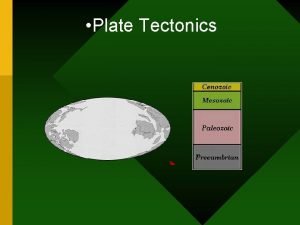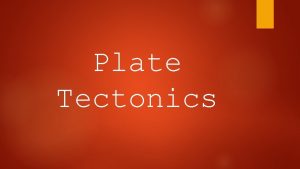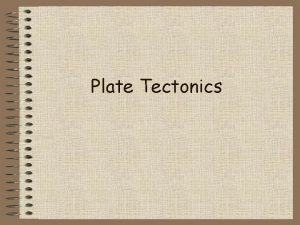Chapter 8 Plate Tectonics 8 1 Earth has














- Slides: 14

Chapter 8: Plate Tectonics 8. 1: Earth has several layers 8. 2: Continents change position over time 8. 3: Plates move apart 8. 4: Plates converge or scrape past each other

8. 3: Plates move apart Before, you learned: The continents join and break apart The sea floor provides evidence that tectonic plates move The theory of plate tectonics helps explain how the plates move Now, you will learn: About different plate boundaries What happens when plates move apart How the direction and speed of plates can be measured

Tectonic plates have different boundaries Plate boundary: where the edges of two plates meet Types of boundaries: Divergent boundary: where plates move apart…mostly found in the ocean Convergent boundary: where plates push together Transform boundary: where plate scrape past each other

The sea floor spreads apart at divergent boundaries Also called spreading centers As the ridges continue to widen, a gap called a rift valley forms Molten material rises to form new crust Mid-Ocean Ridges and Rift Valleys Mid-Ocean Ridges: like a long chain of mountains. Rift Valley at center magnetic reversal animation

Divergent Boundaries – Mid-Ocean Ridges and Rift Valleys World’s longest ridge: Mid-Atlantic Ridge Length of the ocean The North and South American plates are moving away from the Eurasian and African plates 11, 000 km (6214 mi) from Iceland to Antarctica 24 km (15 mi) wide and 9 km (6 mi) deep

Sea-Floor Rock and Magnetic Reversals Scientists studied the sea floor rock and were surprised by a discovery they made about the Earth’s magnetic field Think of Earth as a bar magnet, with a N and S pole (not the geographic pole) Poles switch places: Magnetic Reversal Caused by changes in the magnetic field


animation

Each magnetic reversal is recorded in seafloor rock Magnetic materials in the new rock line up with the Earth’s magnetic field The material hardens and those minerals are permanently fixed in the directions pointing north and south Date the rocks, and can have further evidence of plate movement Most recent reversal: 760, 000 years ago Animation More animations http: //www. edumediasciences. com/en/a 108 -earth-smagnetic-field

Continents split apart at divergent boundaries Continents also spread apart at divergent boundaries Boundary begins to form when hot material rises from deep in the mantle Heat causes the crust to bulge upward Crust cracks, a rift valley forms Magma rises through the cracked, thinned crust forming volcanoes Rift valley grows wider, the continents begin to split apart The thinned valley floor sinks lower and lower until it is below sea level Water may fill the valley

Hot Spots can be used to track plate movements Hot spots: where heated rock rises in plumes (thin columns) from the mantle Volcanoes often develop above the plume Often far from plate boundaries, but offer a way to measure plate movement Heat from the plume partly melts some of the rock in the tectonic plate above it: eventually the rock above will melt A volcano will form at the surface of the plate in time Rises above the sea: an island Movement: can measure direction and speed of plate movements



The lithosphere is made up of many plates Ex: about ½ the African Plate lies under water 1) have the continents always been where they are today? 2) if not, how did they move to their present positions… Mystery Solved! - Section
 Chapter 10 plate tectonics
Chapter 10 plate tectonics Chapter 8 plate tectonics
Chapter 8 plate tectonics Chapter 8 plate tectonics
Chapter 8 plate tectonics Plate tectonics vs continental drift
Plate tectonics vs continental drift What are four types of plate boundaries?
What are four types of plate boundaries? Plate motion calculator
Plate motion calculator The plate tectonics theory states that:
The plate tectonics theory states that: Continental drift vs plate tectonics
Continental drift vs plate tectonics Compare continental drift and plate tectonics
Compare continental drift and plate tectonics Plate tectonics webquest answers
Plate tectonics webquest answers Inner core vocabulary
Inner core vocabulary Continetial drift
Continetial drift Seafloor spreading material at trenches
Seafloor spreading material at trenches Plate tectonics definition
Plate tectonics definition Driving force of plate tectonics
Driving force of plate tectonics
